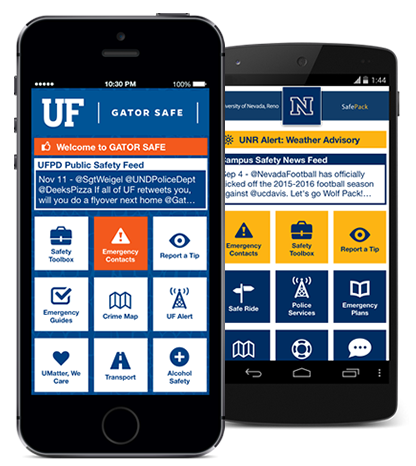Sadly, a customizable mobile safety and security app for college and university students is being welcomed on top Canadian and U.S. campuses.
But with as many tragic and disturbing examples of insecurity, threats and violence on campus as there are these days, the need for such as app is very understandable.
Students, faculty and staff all deserve to enjoy safety, security and comfort while they are on campus, and they should be confident that if there is a need, that help can be summoned at the touch of a button.

A customizable mobile safety and security app for college and university students is being welcomed on top Canadian and U.S. campuses.
The new smartphone security app, called AppArmor, gives users instant access to their campus’ safety resources; of course, that is to improve emergency responses in a crisis but also to raise awareness of and appreciation for the importance of those services before they are needed.
The safety app’s push notification feature was used to alert students at Laurier University when a BB gun assailant was spotted on campus, and in which areas to take extra caution. The safety app also allows students to report any sightings of the BB gun to campus security.
Campus police have long used available resources for campus safety and security, such as the ‘Blue Light’ system which sees the installation of physical emergency alarm stations at various locations on campus. Digital signage networks and large-size video display screens are also used to convey campus news, updates and details about any emergency situations that may arise in real-time.
The next step in increasing student safety on campus is personal and mobile – it follows students as closely as their smartphone does.
In an effort to increase campus safety, Dalhousie University, Red River College, UBC Okanagan, Georgian College in Canada and the University of Florida are among the many education institutions that have worked with AppArmor to develop custom mobile safety apps for their specific environment.

Dalhousie University (pictured), Red River College, UBC Okanagan, Georgian College in Canada and the University of Florida are among the many education institutions that have worked with AppArmor.
The safety app (available for all mobile platforms) is built on core capabilities and functions, but can be customized to interface with an educational institution’s existing safety systems, including offline emergency plans, student support services and more.
The app can be used to push out an unlimited number of mass notifications and announcements, and it supports real-time chat with a central identified dispatch service.
The notifications reach users when they are connected to Wi-Fi or cellular, and can be triggered even when the app isn’t running. A certain amount of ‘offline’ information is available, such as a list of available campus safety resources and information on local emergency procedures.
Being mobile, of course the app can provide invaluable geo-location tracking and interactive mapping features, and it has a safety toolbox that by tapping into a smartphone’s built-in features, instantly offers up a loud alarm and/or bright flashlight function as needed.
The advantages of using mobile safety apps are illustrated by recent events at the Vancouver Island University, where the campus security department used the safety app to issue a campus wide lockdown just minutes after an armed intruder was spotted.
Developers behind the AppArmor offering can customize the features and functions based on campus requirements, and they can integrate an administrator’s dashboard feature into the system so that campus officials can control the app and add specific features as required.

Safety and security systems will not work as well as intended if users have any concerns about its operation or capabilities, such as from a personal privacy and data security perspective.
(Be it on campus, in the workplace or the broader consumer marketplace, the need for a broad consensus on the use of such tools is imperative. Safety and security systems will not work as well as intended if users have any concerns about its operation or capabilities, such as from a personal privacy and data security perspective.
A case in point: students and faculty at the University of California are up in arms having learned recently that a computerized security system installed there monitors all Internet traffic on the system and actually stores records of its users’ online interactions for up to 30 days.
The campus community notes that its new President, Janet Napolitano, used to serve as the U.S. Secretary of Homeland Security, with some unease.)
So, operational and implantation buy-in from the users is just as important to the success of a campus security system as its features and functions, if not its actual price.
In the case of App Armor, the costs to a university or college for the app is based on the mobile platform used (iOS, Android or BlackBerry); the specific features installed and functions developed; as well as the number of users of the system. A one-time development and system set-up fee (approx. $2-3,000) applies, as does a monthly service charge (approx. $200).
AppArmor comes from parent company CutCom Software, which developers a wide range of custom mobile, tracking and notification systems. CutCom was founded by a pair of university students, brothers in fact from Queen’s University in Kingston, ON.
Computer science grad Chris Sinkinson and his younger brother David, who is the “marketing and sales guy” are the entrepreneurial and digital savvy team driving the company’s growth.
“We’re very excited to see that institutions in Canada and the U.S. are choosing our platform,” David said in a statement. “We look forward to seeing these apps … playing a role in improving campus safety.”
# # #
-30-




These mobile safety tips helped me out. I work in one of the best universities in Canada, and I needed to make sure that my phone was secure. I was able to do that using these tricks.